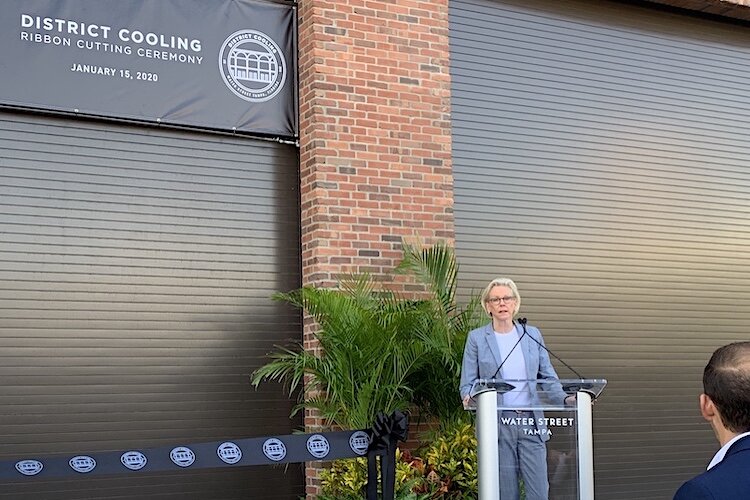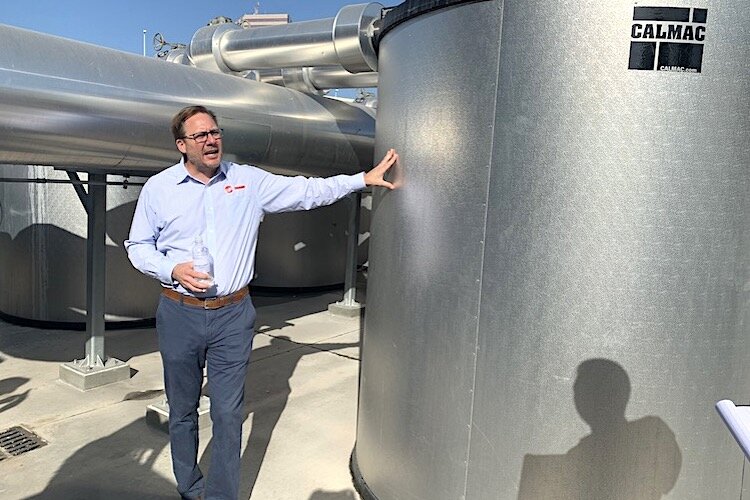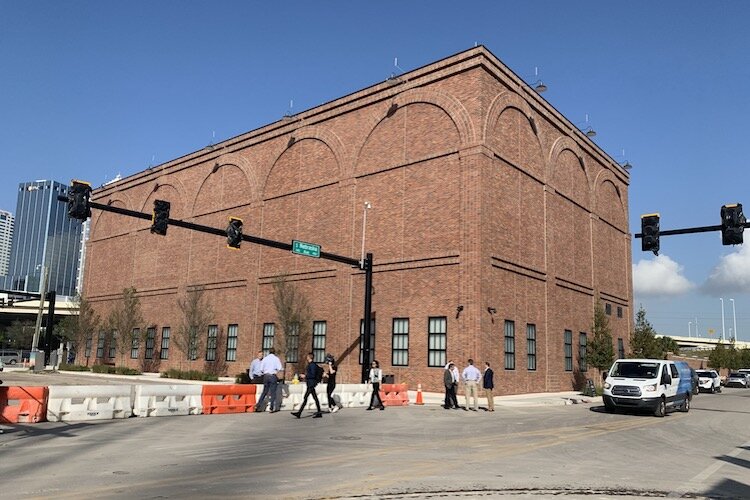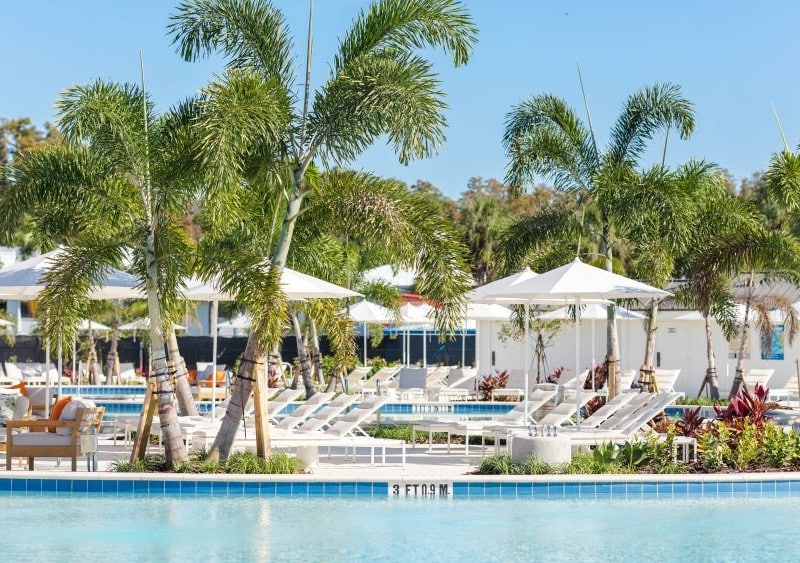How to be cool: Water Street Tampa chiller plant sports innovation
Water Street Tampa's state-of-the-art District Cooling facility does more than keep the insides of nearby homes and businesses at a comfortable temperature. The chiller plant represents a forward-thinking, environmentally friendly leap into the future.
Tampa boasts one of the warmest average year-round high temperatures in the continental United States at a balmy 82 degrees Fahrenheit. But the heat won’t keep people away from Water Street Tampa, a WELL-certified community designed for waterfront urban living on 56 acres surrounding Amalie Arena in downtown Tampa.
A new chiller plant on the northwest corner of South Nebraska Avenue and East Cumberland Avenue will help keep folks in the emerging neighborhood cool and comfortable. Yet, the state-of-the-art District Cooling facility does more than keep the insides of nearby homes and businesses at a comfortable temperature. The chiller plant represents a forward-thinking, environmentally friendly leap into the future.
How does the chiller plant work?
The basic science behind modulating indoor temperatures hasn’t changed much since 1902 when 25-year-old engineer William Carrier invented the first modern air conditioner. Most air conditioners use mechanisms that blow air over water-cooled coils and help transfer heat away from indoor areas and subsequently lower temperatures.
In the most basic sense, air conditioners work the same way now as they did in 1927 when Tampa Theatre in downtown Tampa became the city’s first commercial building to use air conditioning. But a lot has changed in perfecting how these cooling systems work, and, now, less than a mile east of Tampa Theatre, some of the most efficient and sustainable air conditioning technology imaginable will help keep the homes and businesses being built in Water Street Tampa cool year-round.
Among the innovations offered by the new District Cooling chiller is its connection to a network of buildings in Water Street Tampa. The large central chiller will efficiently distribute chilled water to the majority of the buildings under construction or planned. This cooled water flows through heat exchangers that absorb heat from buildings before it recirculates to the central plant in the enormous closed-loop system.
Some 8,500 linear feet of insulated steel pipes, some as large as 30 inches in diameter, run as deep as 20 feet underground from the chiller plant throughout the neighborhood.
“We send water out at 39 degrees and it comes back to our plant at 57 degrees,” notes Tampa Bay TRANE VP Stephen Koontz.
The heart of the system, contained within a 12,500-square-foot, three-story-tall building, contains one 1,500-ton TRANE ice-making centrifugal chiller and two 2,500-ton TRANE duplex centrifugal chillers. On top of the roof stand six 1,250-ton Marley cooling tower cells.
“A ton,” Koontz explains, “refers to the amount of ice historically used in an air conditioning system during a 24-hour period,” noting that system of measurement dates back to the early days of air conditioning when 2,000-pound (1-ton) blocks of ice were used in cooling. The more tons involved, the larger and more powerful the air conditioning system.
The ice in the District Cooling plant is stored in 98 Calmac ice-storage tanks lined up in rows three abreast outdoors just to the north of the facility’s main building. Each Calmac ice storage tank has a capacity of several hundred gallons. Helping move the chilled water around the facility and into the distribution pipes throughout the district are 11 system pumps and six 3,000-amp electricity distribution units to help ensure the whole system operates. The chiller plant is tied to two TECO substations, so in the event that the power goes out at one substation, an automatic relay will allow power from the other substation to kick in.
Overall, the chiller plant is immense — it’s one of the largest of its kind in the Tampa Bay region. The system currently has an 8,000-ton capacity and is providing cooling services for a few buildings in Water Street Tampa, including the recently opened University of South Florida Health Morsani College of Medicine and Heart Institute and Taneja College of Pharmacy. And there is still room to expand as the designed community grows in the years ahead.
“We have the capability to add two more 2,500-ton chillers and three more cooling towers,” Koontz says.
Responsible climate control
In the mechanical sense, District Cooling is not much different than other chiller plants in the area.
“Every one of these tall office buildings has a similar plant,” says Koontz.
But that’s where the similarities between ordinary chiller plants and the new one in Water Street Tampa end.
“Water Street planned this well ahead and doing upfront planning and consolidating the cooling equipment all into one plant is a very sustainable way to develop a community,” Koontz says. “We get to use a lot less equipment because we all share it, and the reason we get to do that is because we don’t all need the cooling capacity at the same time.”
Most residents will be using the air conditioners in their condos during the mornings and evenings, but not during the bulk of the day. That’s when usage shifts to businesses and restaurants throughout the community.
“So, the cooling load will shift to where the people go in a given day – to the office in the mid-mornings through afternoons and to the bars and restaurants later in the evenings.” Koontz remarks such a system, which aggregates the cooling needs of an entire network of buildings, can reduce cooling needs by 30% to 40%, making it far more efficient than individual cooling plants for separate buildings.
Hillsborough County Commissioner Pat Kemp says those energy reductions make a big impact at the environmental level.
“We’re saving 180,000 tons of carbon,” she says. “It’s really helping our carbon footprint. This is a wonderful, great step forward.”
Tampa Mayor Jane Castor echoes similar praise for the District Cooling plant, which she says represents the resiliency and sustainability being built into the entire Water Street Tampa.
“We went through a number of research agencies and organizations deeming us as the epicenter for climate change here in the Tampa Bay Area,” Castor says. “I have no doubt that we will be able to mitigate the effects of sea-level change and climate change while reducing the carbon footprint. And I can’t think of a better example right now than this chiller plant and the efficiency of it and everything it does to cool the entire Water Street area while helping create more green space on top of buildings where chillers went before.”
Holistic benefits
The added room for greenspace, community-gathering areas, gardens, and other amenities on the ground and on top of buildings is a major boon for Water Street Tampa and for downtown Tampa.
Upon completion, Water Street Tampa will boast 13 acres of public space, nine million square feet of mixed-use development, pedestrian-oriented streets, and a walkable design aimed at connecting people with the surrounding community. These dynamic innovations are anticipated to help Water Street Tampa become the world’s first WELL-certified neighborhood, a coveted designation bestowed by the International WELL Building Institute and awarded to businesses and developments built around human-centric designs aimed to provide a healthy, well-rounded lifestyle.
The diverse concepts of air, water, nourishment, light, fitness, sound, mind, temperature, materials, and community are at the heart of what the master planners behind the community project embraced when designing Water Street Tampa. And planning for a centralized chiller system as part of the network of community infrastructure helps provide a feasible solution for achieving those goals.
“There are myriad benefits offered to future residents, businesses, and visitors,” says Charlie Rollins, SPP Director of Development and Construction, about the new District Cooling plant. “Chillers are loud, and this one being isolated away from other buildings helps reduce noise and vibrations usually caused by chilling plants. … It also allows us to offer a more resilient infrastructure.”
Contributing to the list of holistic benefits for the community is the aesthetic design of the chiller plant structure itself. While the building designed by Florida-based Baker Barrios includes 21st-century innovation inside, the outside of the edifice offers a humble nod to the past.
“We wanted to pay homage to the historical architecture of the nearby community of Ybor City, with its old cigar factories,” notes Darren Morse, senior manager of development at SSP. “So, we clad the entire façade of the building in a thin veneer of red brick.”


















